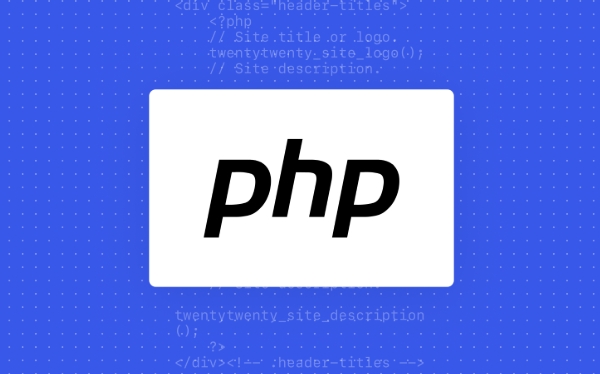Learning PHP: A Beginner's Guide
To learn PHP effectively, start by setting up a local server environment using tools like XAMPP and a code editor like VS Code. 1) Install XAMPP for Apache, MySQL, and PHP. 2) Use a code editor for syntax support. 3) Test your setup with a simple PHP file. Next, learn PHP basics including variables, echo, functions, and arrays while understanding server-side execution. Then, apply knowledge through small projects like a contact form or to-do list to reinforce handling inputs, databases, and sessions. Finally, adopt security practices early such as input validation, prepared statements, and secure password handling to build safe habits from the start.

If you're thinking about learning PHP, you’re probably looking to get into web development. PHP is a server-side scripting language that powers a huge chunk of the web — including big names like WordPress and Facebook (in its early days). It's beginner-friendly, widely used, and still relevant today. Whether you want to build dynamic websites or contribute to existing projects, PHP is a solid starting point.

Set Up Your Environment: Start Simple
Before writing any PHP code, you need a place to run it. Unlike client-side languages like JavaScript, PHP runs on the server, so you’ll need a local server environment set up on your machine.
Here’s how to get started quickly:

- Install XAMPP – This free tool includes Apache (web server), MySQL (database), and PHP — all in one package.
- Use VS Code or another editor – A good code editor makes writing PHP easier with syntax highlighting and extensions.
-
Test your setup – Create a simple
.phpfile and run it through your local server to make sure everything works.
Don’t overcomplicate this step. Many beginners get stuck here trying to configure everything perfectly. Just get something working first — you can always optimize later.
Learn the Basics: Syntax and Structure
PHP has a straightforward syntax that mixes well with HTML. You'll start by learning variables, data types, control structures (like loops and conditionals), and functions.

Some key concepts to focus on:
- Variables start with
$, like$name = "John"; - Use
echoto output text or variables to the browser. - Functions let you reuse code — for example, creating a custom greeting function.
- Arrays and associative arrays are used heavily, especially when dealing with database results.
One common mistake is not understanding how PHP executes — remember, it runs on the server, so users never see your actual PHP code. What they see is the HTML output generated by PHP.
Work on Small Projects: Apply What You Learn
The best way to learn PHP is by doing. Once you're comfortable with the basics, try building small functional projects. Here are a few ideas:
- A basic contact form processor
- A to-do list with file-based storage
- A simple blog system using MySQL
These projects help reinforce concepts like handling user input ($_POST, $_GET), working with databases, and managing sessions. Don’t worry if things break — debugging is part of the process.
A good next step after mastering small scripts is to explore PHP frameworks like Laravel or Symfony. They provide structure and tools that speed up development, but it’s best to understand vanilla PHP first.
Understand Security Basics Early On
Security isn't something you should ignore, even as a beginner. Since PHP often handles forms, databases, and user logins, it's important to write secure code from the start.
Common security practices include:
- Sanitizing and validating user inputs
- Using prepared statements when interacting with databases (to prevent SQL injection)
- Never storing passwords in plain text — use
password_hash()andpassword_verify()
Many tutorials skip these parts, which can lead to bad habits. Make it a habit to think about security every time you handle user data.
Learning PHP doesn’t have to be overwhelming. Start small, build real things, and keep security in mind. It’s a practical language that gives you immediate results, which helps keep motivation high. As you grow more confident, you can dive into advanced topics like object-oriented programming, REST APIs, or modern frameworks. But for now, just getting something working is the goal.
The above is the detailed content of Learning PHP: A Beginner's Guide. For more information, please follow other related articles on the PHP Chinese website!

Hot AI Tools

Undress AI Tool
Undress images for free

Undresser.AI Undress
AI-powered app for creating realistic nude photos

AI Clothes Remover
Online AI tool for removing clothes from photos.

Clothoff.io
AI clothes remover

Video Face Swap
Swap faces in any video effortlessly with our completely free AI face swap tool!

Hot Article

Hot Tools

Notepad++7.3.1
Easy-to-use and free code editor

SublimeText3 Chinese version
Chinese version, very easy to use

Zend Studio 13.0.1
Powerful PHP integrated development environment

Dreamweaver CS6
Visual web development tools

SublimeText3 Mac version
God-level code editing software (SublimeText3)

Hot Topics
 A Simple Guide to PHP Setup
Jul 18, 2025 am 04:25 AM
A Simple Guide to PHP Setup
Jul 18, 2025 am 04:25 AM
The key to setting up PHP is to clarify the installation method, configure php.ini, connect to the web server and enable necessary extensions. 1. Install PHP: Use apt for Linux, Homebrew for Mac, and XAMPP recommended for Windows; 2. Configure php.ini: Adjust error reports, upload restrictions, etc. and restart the server; 3. Use web server: Apache uses mod_php, Nginx uses PHP-FPM; 4. Install commonly used extensions: such as mysqli, json, mbstring, etc. to support full functions.
 Commenting Out Code in PHP
Jul 18, 2025 am 04:57 AM
Commenting Out Code in PHP
Jul 18, 2025 am 04:57 AM
There are three common methods for PHP comment code: 1. Use // or # to block one line of code, and it is recommended to use //; 2. Use /.../ to wrap code blocks with multiple lines, which cannot be nested but can be crossed; 3. Combination skills comments such as using /if(){}/ to control logic blocks, or to improve efficiency with editor shortcut keys, you should pay attention to closing symbols and avoid nesting when using them.
 Tips for Writing PHP Comments
Jul 18, 2025 am 04:51 AM
Tips for Writing PHP Comments
Jul 18, 2025 am 04:51 AM
The key to writing PHP comments is to clarify the purpose and specifications. Comments should explain "why" rather than "what was done", avoiding redundancy or too simplicity. 1. Use a unified format, such as docblock (/*/) for class and method descriptions to improve readability and tool compatibility; 2. Emphasize the reasons behind the logic, such as why JS jumps need to be output manually; 3. Add an overview description before complex code, describe the process in steps, and help understand the overall idea; 4. Use TODO and FIXME rationally to mark to-do items and problems to facilitate subsequent tracking and collaboration. Good annotations can reduce communication costs and improve code maintenance efficiency.
 Improving Readability with Comments
Jul 18, 2025 am 04:46 AM
Improving Readability with Comments
Jul 18, 2025 am 04:46 AM
The key to writing good comments is to explain "why" rather than just "what was done" to improve the readability of the code. 1. Comments should explain logical reasons, such as considerations behind value selection or processing; 2. Use paragraph annotations for complex logic to summarize the overall idea of functions or algorithms; 3. Regularly maintain comments to ensure consistency with the code, avoid misleading, and delete outdated content if necessary; 4. Synchronously check comments when reviewing the code, and record public logic through documents to reduce the burden of code comments.
 Quick PHP Installation Tutorial
Jul 18, 2025 am 04:52 AM
Quick PHP Installation Tutorial
Jul 18, 2025 am 04:52 AM
ToinstallPHPquickly,useXAMPPonWindowsorHomebrewonmacOS.1.OnWindows,downloadandinstallXAMPP,selectcomponents,startApache,andplacefilesinhtdocs.2.Alternatively,manuallyinstallPHPfromphp.netandsetupaserverlikeApache.3.OnmacOS,installHomebrew,thenrun'bre
 Writing Effective PHP Comments
Jul 18, 2025 am 04:44 AM
Writing Effective PHP Comments
Jul 18, 2025 am 04:44 AM
Comments cannot be careless because they want to explain the reasons for the existence of the code rather than the functions, such as compatibility with old interfaces or third-party restrictions, otherwise people who read the code can only rely on guessing. The areas that must be commented include complex conditional judgments, special error handling logic, and temporary bypass restrictions. A more practical way to write comments is to select single-line comments or block comments based on the scene. Use document block comments to explain parameters and return values at the beginning of functions, classes, and files, and keep comments updated. For complex logic, you can add a line to the previous one to summarize the overall intention. At the same time, do not use comments to seal code, but use version control tools.
 Learning PHP: A Beginner's Guide
Jul 18, 2025 am 04:54 AM
Learning PHP: A Beginner's Guide
Jul 18, 2025 am 04:54 AM
TolearnPHPeffectively,startbysettingupalocalserverenvironmentusingtoolslikeXAMPPandacodeeditorlikeVSCode.1)InstallXAMPPforApache,MySQL,andPHP.2)Useacodeeditorforsyntaxsupport.3)TestyoursetupwithasimplePHPfile.Next,learnPHPbasicsincludingvariables,ech
 Mastering PHP Block Comments
Jul 18, 2025 am 04:35 AM
Mastering PHP Block Comments
Jul 18, 2025 am 04:35 AM
PHPblockcommentsareusefulforwritingmulti-lineexplanations,temporarilydisablingcode,andgeneratingdocumentation.Theyshouldnotbenestedorleftunclosed.BlockcommentshelpindocumentingfunctionswithPHPDoc,whichtoolslikePhpStormuseforauto-completionanderrorche







